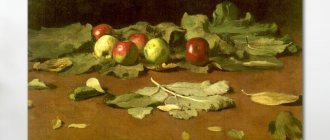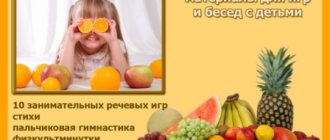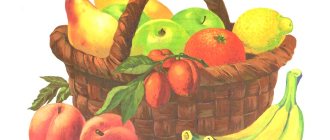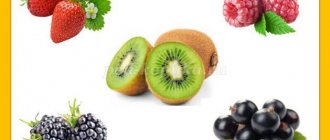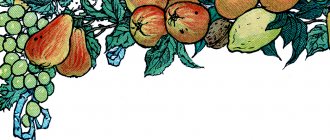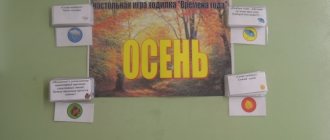Fruits:
materials for games, conversations and activities with preschool children. Finger gymnastics. Entertaining speech exercises and games for children. Physical education minutes. Cartoons.
In this article you will find:
- Conversation about fruits.
- 10 speech games on the topic “Fruits”.
- Finger gymnastics.
- Three ideas for physical education minutes.
Additional material for the article - riddles about fruits can be found in the article "Riddles"
Paintings on the theme “Fruit”
Ilya Efimovich Repin “Apples and Leaves”
We all know Ilya Efimovich Repin as a master of portraiture and a master of large canvases on mythological and historical themes (for example, the painting “Barge Haulers on the Volga,” which we discussed in the topic “Professions”). Still life was not the artist’s main genre, and we can say that the painting “Apples and Leaves” was created by accident. The still life, combining fruits and leaves, was created and staged by Repin for his student, young V.A. Serova. But the teacher liked the composition so much that he decided to paint such a still life himself.
A completely simple plot: six apples from the garden and a heap of leaves, but it’s all so native, Russian, realistic. The yellowish-green and red apples are not depicted as ideal “waxy” fruits, but as real, living fruits should look. It is felt that they have irregularities, dents and small spots. The simplicity of the painting makes the canvas a masterpiece worthy of the world's best halls and exhibitions.
Ilya Efimovich Repin loved nature very much. He lived 86 years and until his old age he slept in the cold, swam in the sea, never spent a day without gymnastics and ate a lot of vegetables and fruits. If Repin had a break from drawing, he found other activities for himself - riding a horse, swimming, working in the garden, planting plants or clearing snow in winter. And he did not hesitate to offer shovels to his guests, for example, Chukovsky, Mayakovsky or Chaliapin. Proper nutrition, physical activity, favorite work and the ability to live simply (without frills) are the main secrets of the longevity of the great artist. As in the painting “Apples and Leaves,” beauty is in simplicity.
Paul Cezanne "Still life with drapery, jug and fruit bowl"
APPLE
The amber apples are ripe on the apple tree. Yana and Yasha ate amber apples. (N. Lunina) Everyone knows what an apple looks like. This is not surprising. An apple is among fruits as a potato is among vegetables. Apple orchards on our planet occupy five million hectares. This is the most common fruit tree. The apple has been known to people since ancient times. There is a mention of this fruit in the Bible. It was the apple that Eve plucked from the tree of the knowledge of good and evil. Ancient Greece is considered the birthplace of the home apple tree. The ancient Greeks and Romans considered the apple a symbol of love and dedicated it to the goddess of beauty. The ancient Germans were sure that apples were the favorite fruit of the gods. They planted apple trees around their houses, hoping that the evil storm god would not throw lightning arrows at them. In Russia, apple trees began to be grown already in the 11th century. In 1051, an apple orchard was founded in the Kiev Pechersk Lavra. The first apple orchards appeared in the Moscow region in the 12th century. by order of Yuri Dolgoruky.
On August 19, Rus' celebrated the Apple Savior. Until this time, apples were not supposed to be picked. On this day, ripe fruits were collected from apple trees and blessed in churches. Apples were given to the poor and homeless. The more beggars you treat, the more abundant the harvest will be next year. Housewives baked apple pie on this day. Several hundred varieties of apples are known in Russia. They are divided into summer, autumn and winter. In the second half of September, winter varieties of apples were collected: Antonovka and Semerinka. The skin of these varieties is thick, with a special waxy coating that protects the fruit from rotting. You can store them until spring. Apples are eaten fresh, dried, soaked and frozen. They are used to prepare juices, compote, jam, jam, marmalade, and jelly. Apples are very useful. It is no coincidence that the Russian people created a fairy tale about rejuvenating apples. Eat them and you will be young and healthy. Apples contain vitamins, sugars, iron, potassium and magnesium salts. RIDDLE Same with a fist, Red barrel. If you touch it with your finger, it’s smooth, And if you bite it, it’s sweet. (Apple) PROVERBS AND SAYINGS • September smells like apple, October smells like cabbage. • No apple falls past the apple tree. • Like the tree, so are the apples.
Music on the theme "Fruit"
Karen Khachaturyan "Cipollino - Prince Lemon"
The middle of the 20th century can be called, without exaggeration, the “golden age” of Russian animation. The artists carefully worked out every stroke, the cartoons were voiced by first-class actors, and great attention was paid to music. The music was bright, memorable, imaginative, capable of capturing a child’s imagination.
For example, remember the wonderful cartoon “Chippolino”, created at the Soyuzmultfilm studio by director B.P. Dezhkin in 1961. I still remember the bright musical compositions that sounded in the cartoon. The music for this cartoon was written by the great Soviet composer Karen Khachaturyan. 13 years later, based on this music, Karen Khachaturian created a children's ballet of the same name.
According to the composer, Gianni Rodari’s fairy tale captivated him so much that its characters lived in his imagination for a long time. “I couldn’t forget the cheerful Cipollino, the gentle Radish, the noble Cherry, the evil, loud Lemon... And for some reason, each hero now appeared to me in a dance,” admitted Karen Surenovich. Thus was born the idea of a ballet, which was embodied in a complete work in 1974. The choreography for the ballet was composed by choreographer Genrikh Mayorov.
The fate of the ballet was brilliant from the very beginning. The composer became famous throughout the world, and the ballet itself became one of the best in contemporary art aimed at children. The main roles in the ballet were performed by such famous dancers as Maris Liepa, Nikolai Tsiskaridze, Nina Sorokina, Marina Kondratieva and many others.
Some information about Karen Khachaturyan. He was born in Moscow into the family of a theater director. In 1949, Karen graduated from the Moscow Conservatory. His teachers and mentors included Dmitri Shostakovich, Sergei Prokofiev and Igor Stravinsky. Shostakovich emphasized Karen Khachaturian’s “depth of thought, masterly development of material, perfection of its implementation, beautifully flowing melodies, amazing sounds.” Karen Khachaturian composed music for symphony and small orchestras, for violin, cello and piano. Wrote five symphonies. Since 1950, Karen Khachaturian has written music for films and cartoons. The most famous of them were: music for “Cipollino” and for the film “Viy” with Natalya Varleya. In 1981 he was awarded the title of People's Artist of the RSFSR.
We invite you to watch the wonderful cartoon “Chippolino” with your children. And discuss many of the topics raised in the cartoon: mutual assistance, courage, inequality. Well, and, of course, find heroes who belong to vegetables. And the music, of course, listen more carefully to the music written by Karen Khachaturyan.
Conversation about fruits L.K. Schleger. 1913
Preparing for the conversation.
There are different fruits in front of the children. They name them, determine their shape, colors. Determined by touch and taste with eyes closed.
Catalogs of fruits should be at hand; drawings in paints (that is, color pictures); artificial fruit
Conversation.
What do fruits grow on? What is the name of the tree on which apples grow? Can plums grow on an apple tree? What does a ripe apple look like? What does it taste like? (Sweet, juicy). Who colored the apple so much? What protects the apple pulp? (Skin). When is the apple ripe? The beauty of an apple tree hung with ruddy apples. Has anyone ever seen an apple tree with apples? What are the apples sitting on?
Who can tell me how an apple grows? Is it always so big and ruddy? What color is an unripe apple? What does it taste like? Before the apple appears, the apple tree blooms. When does it bloom? In the spring. Has anyone seen an apple tree in bloom? We'll look at it in the spring, but for now let's look at the picture.
Let's see what's inside the apple , cut it - one lengthwise, the other across. What are the seeds in and how many are there? Why do apple trees need seeds? Why do you need pulp? She guards the seeds. What color are ripe seeds? What about the unripe ones?
What kind of seeds do cherries have? At the plum?
Who eats ripe fruits? Do some people eat and love them? Do people eat seeds? They spit them out. What do birds eat? Seeds fall on the ground, and what grows from them?
What do you sometimes find in apples, pears, plums? Worm. How did the worm get into the apple tree? Does the worm remain in the apple? He gnaws it and comes out (find an apple with a worm in it). A worm is made into a pupa, and a pupa is made into a butterfly.
What do we make from fruits? What do we make jam from? Has anyone ever seen dried fruit? Show and try. What else is made from fruits? Kvass, liqueur.
Do we grow grapes? What do they make from it? What other fruits do you know that grow in warm countries? Oranges, tangerines, lemons. Are the skins of oranges and lemons as thin as those of an apple?
What fruits does an oak tree or a Christmas tree have? Who collects and eats them? Is this fruit?
Children's work on the topic "Fruits".
- Modeling fruits, drawing them.
- Cutting and pasting (applique).
- Cutting out pictures of fruits from catalogs and magazines.
- Illustration “Apple picking”.
- Fruit stand (making a model for children's games together with the children)
Question for educators to consider:
Exactly 100 years have passed since the publication of this conversation for young children by the talented teacher Louise Karlovna Schleger! Have we and our children changed? What is different about the conversation about fruits by L.K. Schleger from modern conversations about fruits in kindergarten? What requirements for a conversation with children were taken into account when compiling this conversation? What would you change about it?
You will learn more about conversations with children and about our history of methods for developing children’s speech from the article “Conversation in kindergarten” based on materials from the book by E.A. Flerina “The Living Word in a Preschool Institution.”
PEAR
Pear is very tasty. We are very sad without a pear. Pear is delicious, especially in jam. (I. Goryunova) In terms of popularity and space occupied, the pear is in third place after the apple and cherry trees. Pear cultivation began a long time ago. The ancient Roman writer Cato the Elder, in his treatise “On Agriculture,” written more than two thousand years ago, gave recommendations on how to properly grow pears. Pliny the Elder described 35 varieties of pears in his work. Unlike modern varieties, pears in ancient Rome were hard. They became soft at the end of the 18th century thanks to the efforts of French and Belgian breeders. One of them, Van Monet, developed 400 varieties of pears, 40 of which are still popular today.
Now the number of pear varieties has exceeded several thousand. Pears are grown in gardens; they also grow on forest edges and in clearings in deciduous forests. It feels good on rocky mountain slopes, as it is not picky about the soil and tolerates drought and light frosts. Pear trees begin to bear fruit in 5–7 years. True, at first the harvest is small. But when the tree gains strength, they get up to 200 centners per hectare. Pears live quite a long time, up to 300 years. The oldest fruit tree in the world is considered to be a pear tree, planted in 1630 within the American city of Denver. A wonderful pear, very sweet, like honey. It just begs to be placed in your palm, and then quickly into your mouth. (N. Migunova) The pear fruit consists of 97% pulp, 2.5% is the skin and only 0.5% is the seeds. It contains vitamins D and C, potassium, magnesium, and iron salts. Pears are eaten fresh, many delicious dishes are prepared from them, jams, jams, compotes are made, pears are dried and pickled. RIDDLE Birds hang upside down on the trees between the leaves. (Pears)
QUINCE
Transcaucasia and Central Asia are considered the homeland of quince; it is in these areas that it is now found in the wild. Quinces have been grown since time immemorial, more than 4,000 years ago. The Latin name for quince is Cytfonia, presumably derived from the city of Cydon on the island of Crete; it was widely cultivated already in the first millennium BC. The ancient Greeks treated the quince with respect; for them it was a symbol of beauty and fertility. It was customary to treat newlyweds to quince. According to one version, the cause of the discord between Hera, Athena and Aphrodite was not an apple, but a quince. Currently, about 400 varieties of quince are known. They differ from each other in the structure of flowers and the shape of fruits. True, the differences between them are not as significant as, for example, between apple varieties.
Quince fruits are yellow in color with different shades, sometimes with a slight blush, very dense, hard and crunchy. If there are greenish spots on the quince, it means that it is not yet fully ripe. The pulp of this fruit is slightly viscous, tart and quite aromatic - the smell has something of an apple, and there is also a coniferous tint. You should only eat ripe quince; it is advisable to give it a chance to age. The longer it sits, the tastier, more aromatic and softer it becomes, the astringent taste disappears. Quince is a very healthy fruit. It contains potassium, magnesium, calcium, vitamin C, malic and citric acids. Quince pulp is rich in pectin. Quince is a universal fruit. It is eaten raw, it makes delicious compotes, jams, preserves, candied fruits, it can be added to porridge, salad, vegetable soup. Quince mustard is a seasoning made from quince and mustard with the addition of ginger and coriander. Quince cheese is condensed quince juice with pulp. Quince is grown in many countries of the world - in Europe, North America, North Africa, East and Central Asia. Cold-resistant varieties have also been developed and are successfully cultivated in the Volga region. Another variety of quince is Japanese quince, or chaenomeles. The flowers and fruits of this plant are similar to quince. Chaenomeles was brought to Europe from Japan at the end of the 17th century. Gradually it gained popularity among gardeners - it has very beautiful decorative flowers. Japanese quince fruits are also edible, but they are more sour.
Pages: 1 2 3 4
